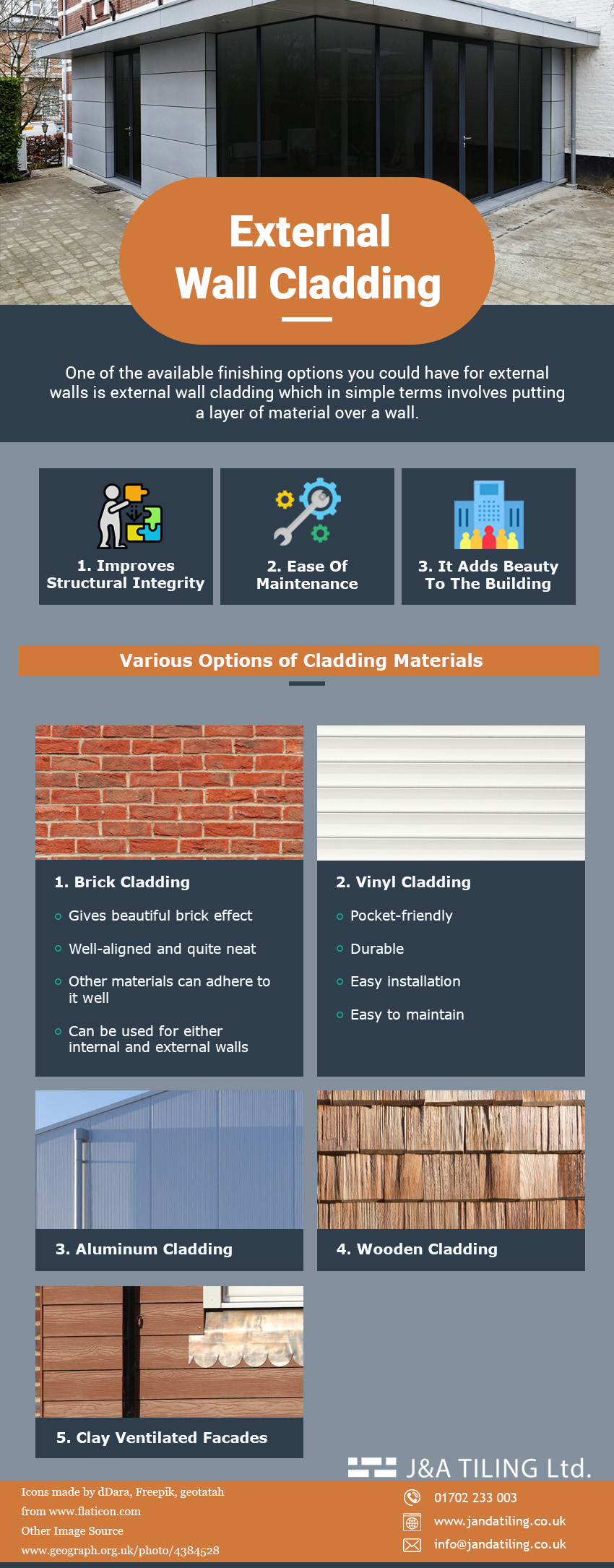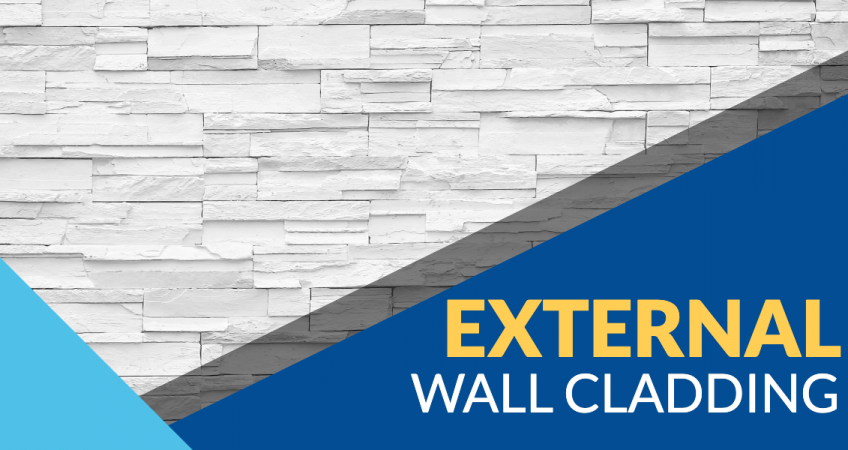When you look at a building, what strikes you the most? Asides the primary function a building serves, aesthetics and quality architecture are quite important in construction for beautifying, comfortability, and durability. For each part of the building, there are many options of finishings to pick from. The choice then depends on various factors most importantly, the cost and the appropriateness.
One of the available finishing options you could have for outside walls is external wall cladding which in simple terms involves putting a layer of material over a wall. There are various materials that can be used for cladding. This article seeks to help you know more about wall cladding and help you make an informed decision when necessary.
Benefits of Wall Cladding
Various wall cladding materials and different application techniques deployed have their advantages. This makes wall cladding a really diverse aesthetic and structural instrument.
1. External Wall Cladding Improves Structural Integrity
A big defacement in construction is a structural blight, especially the one that arises due to deficiencies in planning, choice of materials or execution of plans. A major reason for wall cladding is for the extra layer of protection it gives to a building. It provides additional mechanical strength to the material used for the wall. Buildings are prone to wear and tear, cracks from climate and extremes of temperature, rains or water from source and sunlight, fire, vibration, pollution, strong winds and so on. External wall cladding significantly reduces the damage from these factors by providing resilience and also insulation.
2. Easy To Maintain
As a sequel to the advantage of improved structural integrity provided by external wall cladding, wall cladding also provides an easily maintainable surface in terms of repairs and cleaning. Depending on the material used, your tolerance for maintenance can be taken into cognisance when making a choice. As opposed to most wall cladding alternatives, some materials like brick and clay cladding might not even need any forms of maintenance. However, polyvinyl chloride cladding might need a special form of machine for cleaning every couple of years.
3. It Adds Beauty To The Building
Although the main purpose of using wall cladding in a building project is rather more structural, the added aesthetics cannot be overlooked. When rightly installed, the right choice of wall cladding can be quite instrumental in dictating the overall outlook of a building, altering its appeal and remarkably adding to its economic value. This is made possible by the variety and blend of materials manufactured to suit various designs – colours, vanishes, and finishes, smooth or rough, depending on the taste of the clients.
Depending on the function the building is to serve, creativity is needed in harnessing the overwhelming possibilities when using wall cladding.
Various External Wall Cladding Options
When it comes to external wall cladding ideas, there are is wide range of material options to choose from. Some of the most common ones are;
1. Brick Effect Cladding

Brick slips can also be called brick tiles or brick veneers. Usually, brick slips are made by literally making a thin cut of the face of existing brick. They are like slices of a real brick or brick tiles which are often used to depict the appearance of a regular brick wall in both internal and outside wall cladding installation. External brick cladding renders a quite rustic texture to the building exteriors. It can absorb water during the rain as it is quite porous, but the water will eventually dry out. Caution has to be applied such that the space between the brick slips has to be sealed to prevent water from seeping through. The brick effect cladding on external walls is highly sought after and is great on older properties where the brickwork has not aged well.
For Brick Slip Cladding In Commercial Properties
Call: 01702 233 003
Exterior brick cladding panels come in various forms and are readily available in various textures and colours for use externally and internally. The material is widely used, and quite comfortable. This makes it a delightful choice of finishing for architects trying to depict traditional values of hospitality and strength in their designs.
Advantages
- Give absolutely that brick effect when external walls are cladded
- Well-aligned and quite neat
- Other materials can adhere to it well
- Can be used for either internal and external walls
Advent in technology has positively altered the manufacturing and installation of this material. Various firms deploy mechanisms aimed at improving the standard in terms of resilience, alignment, neatness, and design. The goal is to ensure suitable penetration into all forms of the substrate, create the natural brick texture and joint width. Installation is made using Polymer Pointing Mortars. Pistol corner bricks are used at building corners, window, and doors. These are used to ensure neat edges and minimise waste thereby ensuring cost-effectiveness.
2. Vinyl Cladding

This is the use of plastic material for cladding. It is used like weatherboard planks and is perhaps the cheapest form of wall cladding. Therefore, it is prevalent and used in many residential buildings. Its durability ensures it adds resilience to the building and also functions as an insulator. It does not rot and cannot be destroyed by insects. With technological dye cast in vinyl resin, the colours cannot be scratched off. Alongside the variety it offers, vinyl is light and easy to install.
The risk it presents in the face of fire is, however, a big limitation of vinyl cladding.
Vinyl cladding is installed usually by hanging, nailing or gluing it to the exterior wall. If there is an existing weatherboard that is not made of wood, you would have to remove it before installing. Plastic will expand when hot and contract when cool depending on the weather. Thus, nailing it too tightly could make the cladding to crack especially older products. This could necessitate repainting or replacing the cracked piece.
Advantages
- Pocket-friendly
- Durable
- Easy installation
- Easy to maintain
Disadvantages
- Potentially flammable
- Poor insulation and temperature regulation
- Does not look so exquisite
3. Aluminum Cladding

This is the most used type of cladding for building exteriors. Aluminum is more often the choice for optimum building cladding when financial, structural and aesthetical functions are considered. Aluminum cladding comes in cladding panels. Coil coating method is used in the manufacturing of most of the aluminum cladding used in buildings. This ensures the preservation of the underlying material. Aluminum is not a heavy metal, but it is durable, resistant to corrosion, and eco-friendly (it is popular in the design of green buildings because it is energy efficient). It is also recyclable. All these mean it could last the existence of humankind.
Relative to vinyl cladding, aluminum cladding would cost you a lot. However, this material offers better durability that allows less frequent replacement and more long-lasting cladding for walls. It is majorly used on the walls of specific rooms like storage and basement.
Like every other cladding type, the colour adds to the aesthetics of the structure thereby providing a beautiful, fun and inspiring place to live or work in. Deploying innovative designs, aluminum cladding sets a building apart.
4. Wooden Cladding

Wood generally gives a feel of nature, and it is often pleasing to sight when used as an external facade. It is most often made from cedar or redwood. It needs expensive maintenance and the installation costs a lot.
It involves wood slats and aluminum profiles that have been anodised. There could be notches depending on the proposed design for the attachment of a fastener. The fastening is well concealed behind the wood. Stainless steel sink is used in place of screws or nails which can corrode. High-quality vanishes are used over the woods. These ensure a delightful outlook.
The wooden cladding is quite resistant to extremes of weather, and the slats are well attached with durable and reliable materials. The wood could be arranged in whatever plane is deemed best suited.
5. Clay Ventilated Facades or Clay Wall Cladding
The beauty of architecture is the unending quest for creativity and application of novel ideas. This has driven an increase in popularity for clay wall cladding. Clay facade tiles are made from clay which has gone through industrial processing. It has been applied in the protection of dormer windows, ends of gables and blinds. This is asides the architectural and technical benefits it offers.
In its highly adaptable state, this external wall cladding idea affords the architect with the luxury of exploring colours, designs, and finishings to give the building a unique touch.
Under the terms of green building and sustainable designs, clay wall cladding is quite relevant. With the rising need for construction in accordance with the standards of performance, energy conservation, and sustainability, structural engineering demands to deploy these sustainable designs. This is clamoured for by proponents of high-performance structural engineering and green building.
Hence, environmental friendliness is a major relevance when clay cladding is considered.
A properly installed wall cladding using clay facade tile ensures superb heat insulation thanks to the great heat buffering ability of ceramics. The clay cladding, in essence, functions as a thermos flask – conserving heat in cold weather and winter.
Advantages of using clay for outside wall cladding include:
- No crack with a change in weather or temperatures
- Remarkable durability
- Does not stain easily
- Can be used in place of plaster and paint
- Ensures neatness with special pieces for corners and junctions
- Can be patterned with varied orientations to add to the beauty
- Suitable for high buildings
- Specially designed rainscreen pocket to further improve durability
- Amazing insulation properties
- Inexhaustible variations are available in colours, designs, and patterns
For More Info On Comercial Externall Wall Cladding, Get In Touch With Our Experts via The Form Below!


